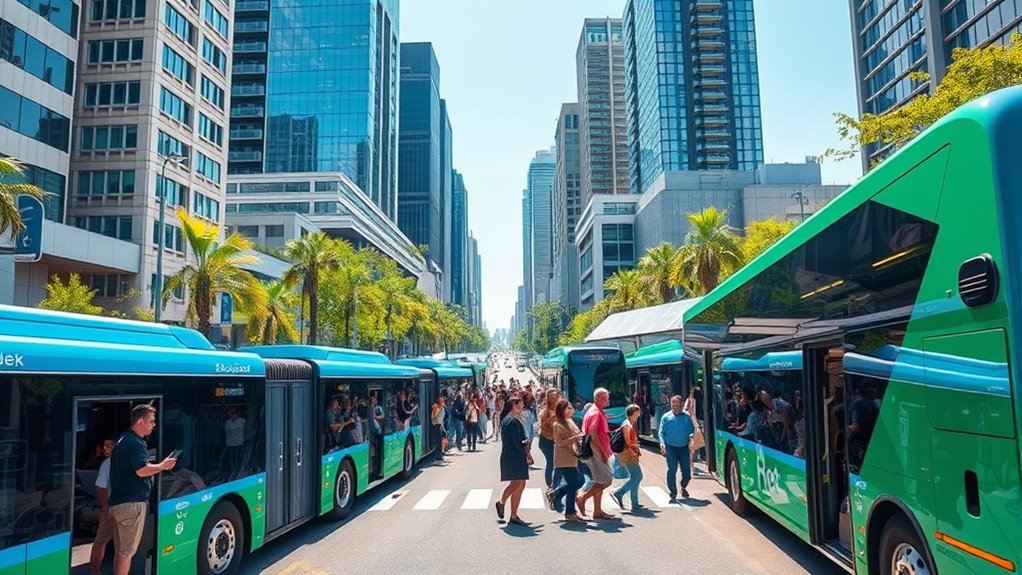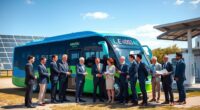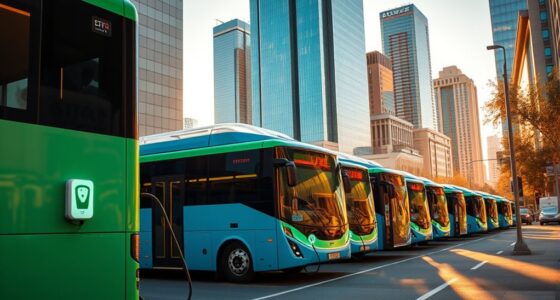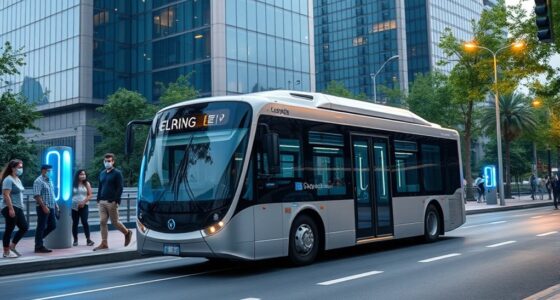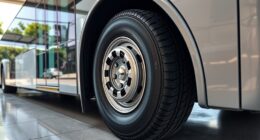The global electric bus market is rapidly expanding, expected to reach over USD 36 billion by 2030 and potentially USD 188 billion by 2032. Leading companies like BYD, Yutong, and MAN are driving innovation in battery tech and infrastructure. This growth is supported by environmental benefits, government incentives, and advancements in vehicle technology. As regional markets diversify and infrastructure improves, opportunities abound. Continue exploring to discover the key drivers fueling this sustainable transportation revolution.
Key Takeaways
- The electric bus market is projected to grow from USD 17 billion in 2024 to over USD 37.5 billion by 2030, driven by technological advances and policy support.
- All-electric buses hold over 90% of revenue share, with rapid innovations in battery tech enhancing range, reliability, and charging speed.
- Regional dynamics show North America and Europe leading in infrastructure and range, while Asia-Pacific and Latin America focus on hybrid and alternative technologies.
- Environmental benefits, such as CO₂ reduction and urban air quality improvements, alongside government incentives, propel market adoption.
- Continuous technological innovation, infrastructure expansion, and regional diversification present significant growth opportunities in the global electric bus industry.
Market Size and Future Projections
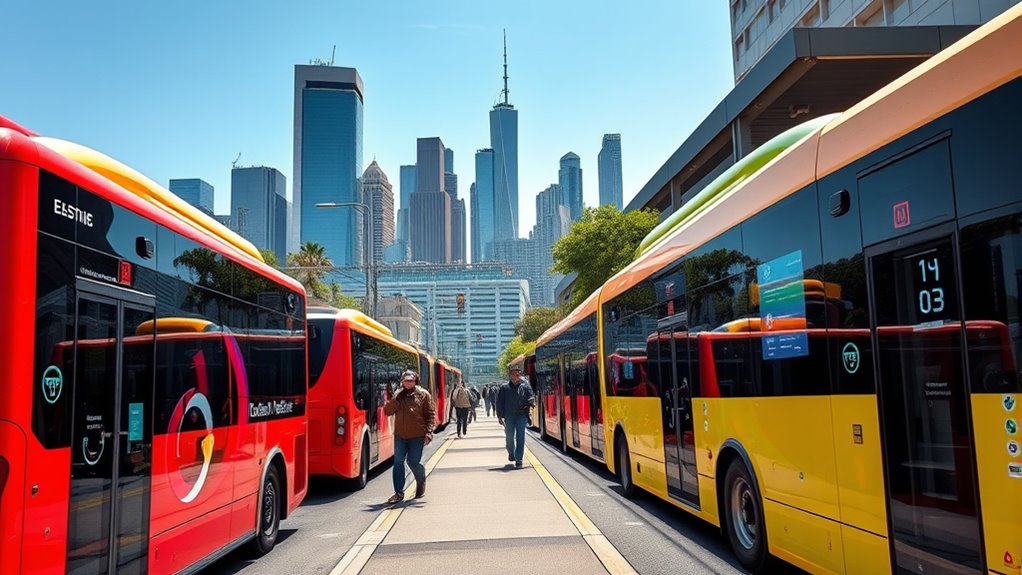
The global electric bus market is experiencing rapid growth, with its value increasing substantially over recent years. In 2024, the market was valued at around USD 17.0 billion, but estimates now place it at approximately USD 36.68 billion.
Experts project the market will reach USD 37.5 billion by 2030, indicating a strong upward trend. Additionally, the market is expected to hit USD 41.04 billion in 2025 and could surge to USD 187.8 billion by 2032.
This rapid expansion is driven by advancements in battery tech, increasing government incentives, and stricter environmental regulations. Overall, the market’s growth at a CAGR of around 11.5% to 14.2% highlights the significant opportunities ahead for electric bus adoption worldwide.
Leading Companies and Competitive Landscape

Leading companies in the electric bus market showcase a diverse mix of global giants and regional players driving innovation and expansion. Yutong, once the market leader, remains a key player, while BYD is renowned for its long-range buses like the K12A. Solaribus & Coach has produced over 23,000 buses, emphasizing quality and reliability. In 2023, MAN emerged as the market leader, overtaking Yutong and Solaris, with Zhongtong maintaining a strong presence in China. The competitive landscape is continually evolving, with market dynamics shaping strategic decisions and investment flows. Many firms adopt strategies like innovation, global expansion, partnerships, and sustainability to strengthen their market positions, creating a competitive landscape ripe with growth opportunities. Additionally, advancements in sound design techniques and tools contribute to the development of more efficient and user-friendly electric buses, enhancing overall market competitiveness. Ongoing research and development efforts further support the integration of advanced technology to improve vehicle performance and passenger experience.
Technological Innovations Driving Growth
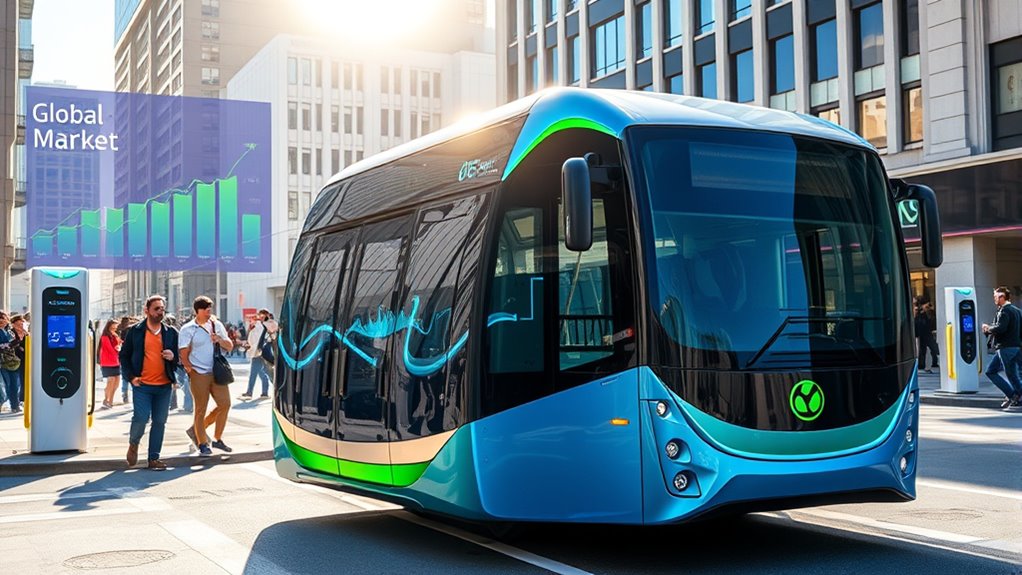
Advancements in technology are fueling the rapid growth of electric buses by enhancing performance, safety, and affordability. Improved battery chemistries now deliver higher energy density, extending range, while costs decrease thanks to economies of scale.
Durability enhancements and better thermal management boost lifespan and reliability, reducing maintenance. Modular battery designs offer flexibility for various bus models. Additionally, ongoing innovations in battery management systems help monitor and optimize battery health, ensuring consistent performance over time. Incorporating advanced thermal regulation techniques further improves battery longevity and safety.
Charging infrastructure innovations include fast chargers that refill batteries in under an hour, wireless charging pads for convenience, and high-power chargers supporting longer routes. Smart charging systems optimize energy use and reduce grid impact, leveraging advances in energy management systems to further improve efficiency.
Autonomous and safety features, like collision warnings, cameras, and radar, improve passenger safety. Energy recuperation, regenerative braking, lightweight materials, and aerodynamic designs increase efficiency.
Additionally, ensuring the quality of battery juice and proper maintenance can further extend the lifespan of electric bus batteries, emphasizing the importance of battery health maintenance.
Together, these innovations drive a more capable, cost-effective, and reliable electric bus market.
Environmental Benefits and Sustainability Impact
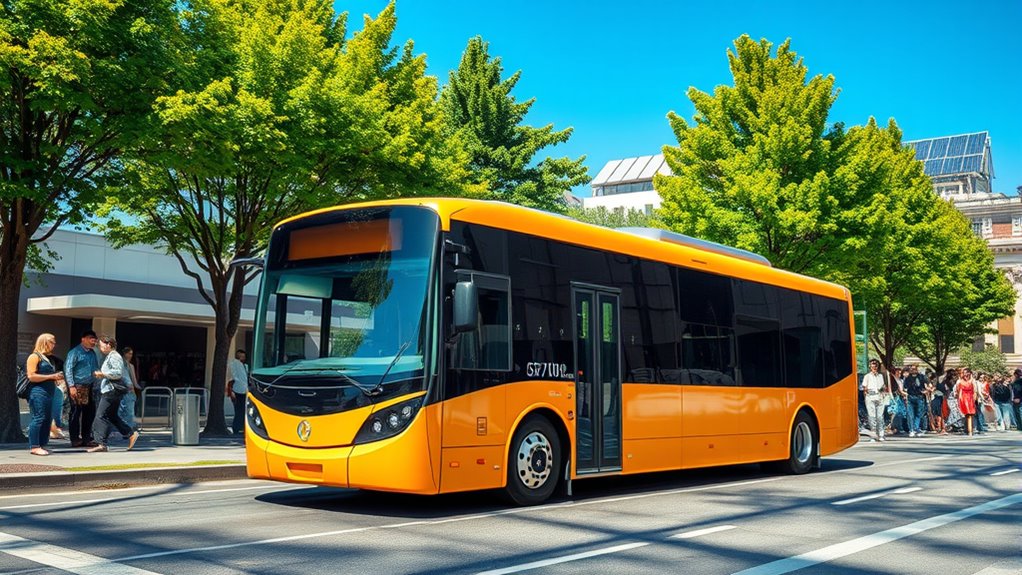
Electric buses deliver significant environmental benefits by eliminating tailpipe emissions, which helps improve urban air quality and reduces harmful pollutants. By switching to electric, you markedly cut air pollutants and greenhouse gases, with each bus saving up to 181 metric tons of CO₂ compared to diesel models. This shift also helps prevent premature deaths and respiratory issues by lowering air pollution levels. Electric buses are more energy-efficient, consuming less energy annually and harnessing regenerative braking to boost efficiency further. They’ve a lower environmental footprint throughout their lifecycle, thanks to reduced emissions and energy use. Additionally, quieter operation creates more peaceful urban environments, enhancing residents’ quality of life. Color accuracy in projectors can also influence the perception of environmental consciousness, as better image quality often correlates with higher-end, eco-friendly technology. Incorporating advanced tuning options can further optimize the performance and energy efficiency of electric bus fleets. Furthermore, ongoing innovation in battery technology continues to improve range and reduce charging times, making electric buses increasingly practical for widespread adoption.
Government Policies and Support Initiatives
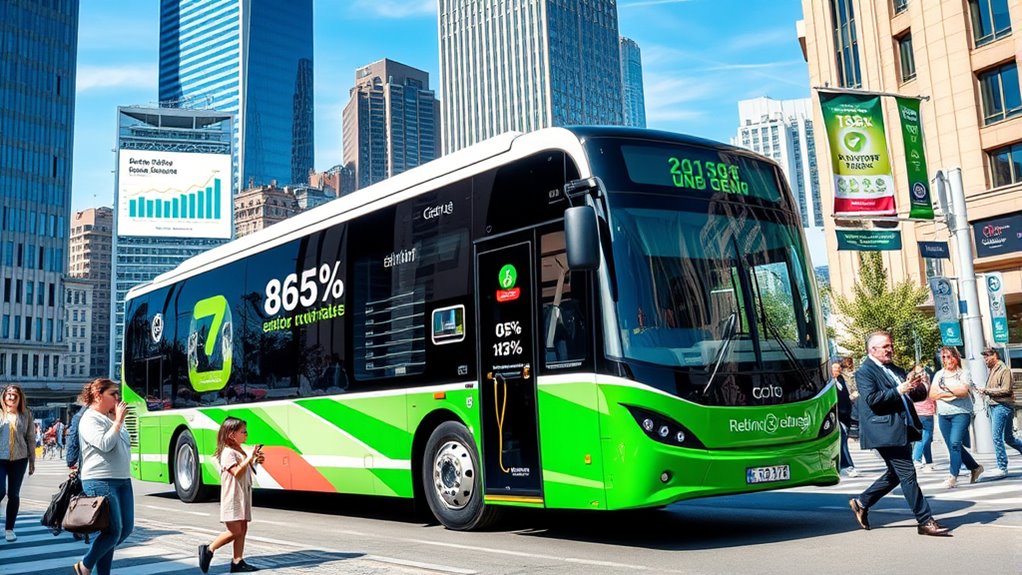
How do government policies and support initiatives accelerate the adoption of electric buses? They provide direct financial support like tax breaks, grants, and subsidies that lower upfront costs. Programs such as the U.S. Clean School Bus Program allocate billions to promote electric school buses, while municipal agencies benefit from subsidies covering large parts of purchase prices. Additionally, organizational systems can play a role in promoting efficient deployment and management of electric vehicle infrastructure at depots and charging stations. Fiscal policies aim to make electric and diesel buses cost-competitive, supported by state grants to ease financial burdens. Infrastructure investments, including charging stations, streamline the shift, with policies combining incentives and network planning. Utility partnerships encourage grid upgrades, and federal-state collaborations fund depots. Active listening these initiatives drive market growth by increasing demand, enabling bulk purchases, and ensuring compliance with emission regulations, ultimately fostering widespread adoption. Furthermore, establishing standardized protocols and efficient deployment strategies enhances the overall effectiveness of electric bus initiatives.
Emerging Trends and Market Diversification
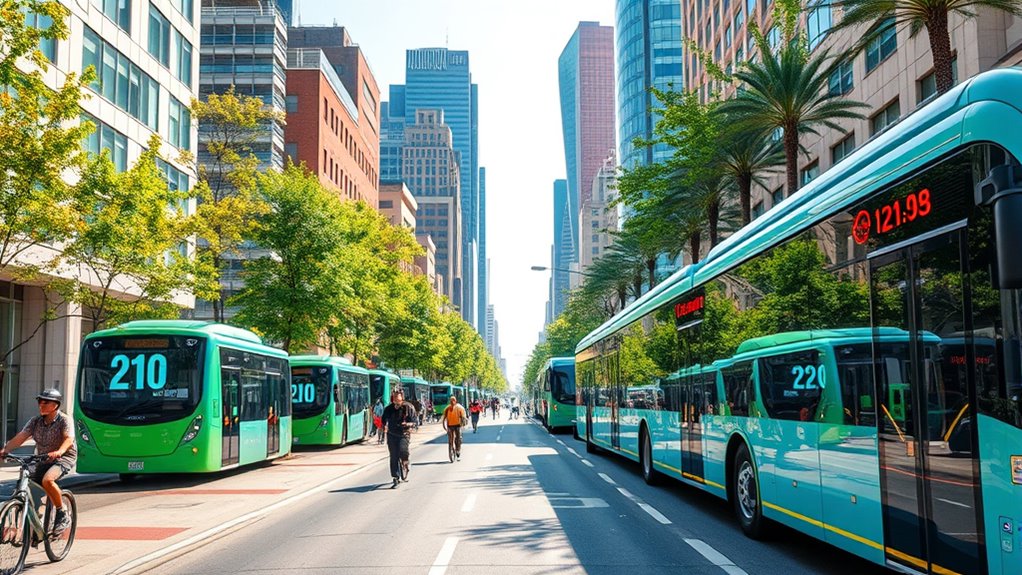
As government policies and support initiatives continue to drive market growth, the electric bus industry is experiencing rapid evolution through emerging trends and diversification.
The market size is expected to more than double from $17 billion in 2024 to about $37.5 billion by 2030, with unit sales soaring from 279,236 to over 1 million units by 2032.
Innovations like longer-range buses above 200 miles and falling battery costs are fueling demand. Advancements in battery technology are crucial in supporting the development of high-range electric buses and expanding market opportunities. Additionally, improvements in skincare patches such as longer adhesion and better absorption are enhancing their effectiveness, paralleling technological progress in the electric bus industry. These battery innovations are enabling manufacturers to develop more reliable and efficient vehicles, further accelerating adoption.
Market diversification is evident in the dominance of all-electric buses, holding over 90% revenue share, with plug-in hybrids and fuel cell models gaining traction in specific regions.
You’ll see regional variations, with North America and Europe leading in range and infrastructure, while Asia-Pacific and Latin America explore hybrid and niche technologies.
Frequently Asked Questions
What Are the Main Challenges Facing Electric Bus Adoption Worldwide?
You face several main challenges when adopting electric buses worldwide. Limited information on their benefits and drawbacks makes decision-making tough.
High upfront costs, scarce financing, and infrastructure expenses add financial hurdles. Insufficient policies, weak government coordination, and negative public perception slow adoption.
Additionally, issues like limited charging infrastructure, grid stability, and long-term planning complicate integration.
Overcoming these obstacles requires coordinated efforts, better data, and supportive policies to unleash electric buses’ potential.
How Do Electric Buses Compare Cost-Wise to Traditional Diesel Buses?
You’ll find that electric buses cost about 50% more upfront than diesel buses. However, over their 12-year lifespan, they save you between $73,000 and $173,000 thanks to lower fuel and maintenance costs.
Electricity is cheaper and more stable, and incentives can help offset initial expenses. Overall, electric buses become more economical over time, making them a smart choice despite the higher initial investment.
What Are the Key Factors Influencing Consumer Acceptance of Electric Buses?
Think of electric buses as a new dance partner—exciting but requiring trust. Your acceptance hinges on performance factors like speed, ride comfort, and safety, which make the ride smooth and reliable.
Environmental concerns motivate you to choose eco-friendly options, while infrastructure availability and ease of use boost confidence.
Social influence and personal norms also play a role, making you more willing to embrace this cleaner, quieter way to travel.
How Is Battery Recycling and Disposal Managed in the Industry?
You should know that battery recycling and disposal are managed through a combination of mechanical disassembly, shredding, and chemical treatments like the COOL process to recover metals such as lithium, cobalt, and nickel.
Industries are working on standardizing practices, creating certifications, and collaborating to improve efficiency.
Proper handling guarantees safety, reduces waste, and promotes environmental sustainability, all while supporting a circular economy with recycled materials reused in new batteries.
What Role Do Private Sector Investments Play in Market Expansion?
Imagine your investments planting seeds in a future forest—private sector investments fuel the electric bus market’s growth. You play a crucial role by funding innovative charging infrastructure, supporting technological advancements, and partnering with governments.
These efforts help overcome barriers like high costs and limited infrastructure. Your involvement drives market expansion, making electric buses more accessible and sustainable, ultimately shaping a cleaner, greener transportation landscape for everyone.
Conclusion
So, as you watch electric buses take over the streets, you might think it’s all smooth sailing. But behind the scenes, fierce competition and rapid innovation make this market anything but dull. While everyone praises sustainability, don’t forget—growth often comes with a dash of chaos. So, sit back and enjoy the ride, because the future of electric buses promises plenty of surprises, even if they’re wrapped in a shiny, green package.
